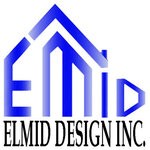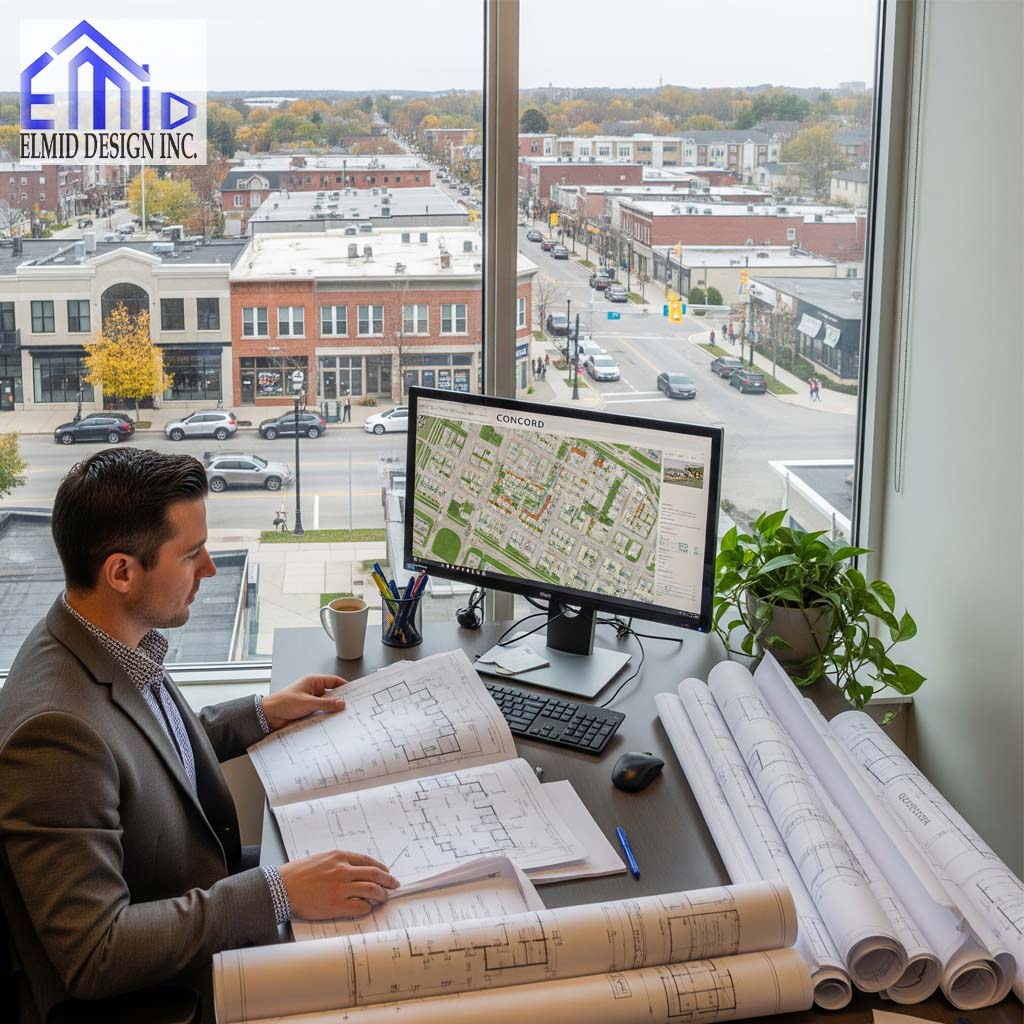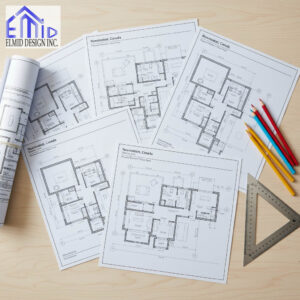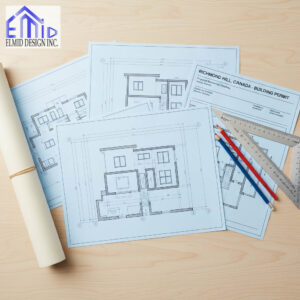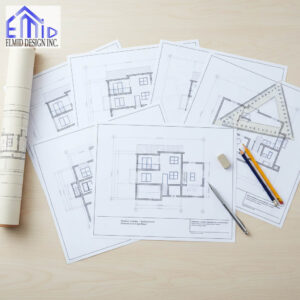Introduction
Permit drawings Concord play a vital role when submitting for a building permit in Concord because they translate your vision into codes and regulations that the city, fire district, and utilities must accept before construction begins. This article walks you through each key step, explains what to submit, and highlights how applicants prove their expertise and credibility—helping you navigate the process confidently and clearly.
Understanding Permit Drawings for Concord
Permit drawings in Concord must meet specific guidelines to satisfy municipal and regulatory requirements. These drawings typically include site plans showing property boundaries, footage from property lines, building footprints, elevations, structural framing, foundation plans and utility connections. They must align with zoning, engineering standards, and environmental requirements. The Engineering Division provides standard drawings, forms, and checklists to guide each applicant.
Submittal Requirements for Permit Drawings Concord
Applicants must include all required documents when they apply. The Building Permit process in Concord generally involves submitting a complete application with site plans, architectural and structural drawings, compliance with energy and fire codes, and documentation of required approvals from outside agencies such as fire, school districts, and air quality boards. The Engineering Division offers checklists and standard forms to ensure submissions are correct and complete.
Coordinating with Other Agencies and Review Timelines
Permit drawings Concord often go through reviews by multiple entities beyond the city building officials. Applicants may need clearance from the Contra Costa County Fire Protection District, Mt. Diablo Unified School District, Bay Area Air Quality Management District, and utility providers before approval. The overall process typically takes eight to twelve weeks, with initial review comments arriving in about twenty to twenty‑five days.
How to Apply for a Permit in Concord
To apply for a permit, applicants either use the city’s online Permit Pal portal or submit in person after meeting with a planner when needed. Applicants pay fees after submittal—within five business days—and construction permits are usually issued within sixty calendar days once the application is complete. Optional preliminary meetings with city planners can help expedite the review and reduce errors.
Utilizing Standard Drawings, Forms, and Checklists
The Concord Engineering Division offers an array of standard drawings, forms, and submittal checklists to help applicants avoid omissions. These include improvement plan checklists, grading checklists, sewer connection forms, and site plan templates that ensure consistency with city standards. These resources demonstrate professional diligence and authority, improving project outcomes.
Ensuring Expertise and Trust Through Accurate Documentation
A professional approach to permit drawings Concord includes accurate documentation and adherence to code standards such as structural, plumbing, mechanical, energy, accessibility, and green building (CalGreen) codes. Demonstrating expertise requires compliance with these codes and clear communication in your documentation. Trust arises when applicants provide complete, precise drawings, and proactively coordinate with all relevant authorities.
Best Practices for Applicants and Designers
Design professionals should anticipate comments from both landlords (if applicable) and the city’s permit office, addressing them in tandem to avoid delays. Submitting all required documents at once reduces review cycles. Leveraging standard forms and early outreach to city planners can prevent common mistakes. Keeping track of review timelines (typically 20–25 days for initial feedback) helps set realistic expectations.

Exploring Standard Drawings, Forms, and Checklists
The City of Concord publishes a comprehensive set of standard drawings that cover features such as storm drain framing, curb and gutter specifications, sidewalk details, sewer line connections, signage locations, and traffic control layouts. These standardized templates streamline drafting and help ensure that permit drawings align with engineering expectations and municipal standards. Accessing these forms early promotes accuracy and conveys authority in documentation.
Using the Virtual Permit Center Efficiently
Concord’s Permit Pal platform serves as a virtual permit center that allows users to apply for permits, check application status, schedule inspections, and view past permit records. This digital interface promotes transparency and expedites the process by reducing in-person visits. Applicants who engage with this system demonstrate awareness of efficient workflows and institutional tools.
Understanding the Complete Permit Application Workflow
Applicants submit their building permit drawings along with all required documentation through the Permit Pal or in person at the Permit Center. After submission, applicants receive instructions to pay fees within five business days. Provided the application is complete, the city issues permits typically within 60 calendar days. This timeline sets clear expectations and helps applicants plan accordingly.
Coordinating with External Agencies for Drawings Approval
Permit drawings must often be routed through other agencies such as the Contra Costa County Fire Protection District, County Health Department, Sanitary District, PG&E for utilities, the Bay Area Air Quality Management District for environmental compliance, and the modular unit approval body at California’s Housing and Community Development Department. Including these entities in the process ensures adherence to broader regulatory requirements and builds trust through compliance.
Leveraging Pre‑Approved ADU Plans to Save Time and Cost
Concord’s pre‑approved Accessory Dwelling Unit (ADU) program offers six free, code‑compliant plan sets in architectural styles like Bungalow/Craftsman, Spanish, Rancher, and Modern. These templates come with floor plans, elevations, and site plan templates. By using them, applicants can significantly reduce plan check fees and obtain building permits in as few as five days. This initiative reflects the city’s commitment to affordability and expedience, reinforcing authority and trust in the permitting process.
Demonstrating Professional Expertise with Modular and Utility Considerations
Applicants installing modular units must ensure HCD‑approved plans for foundation design, utility hook‑ups, disabled access, and safe exits. Permit drawings must reflect these requirements to gain approval. Coordinating early with utilities such as water districts is vital. For instance, the Contra Costa Water District guides applicants on water service requirements and standard details for new construction projects. Effective planning here shows professionalism and technical competence.
Setting Expectations Through Timeline Management
Knowing that standard review takes 60 days for complete applications, or as few as five days for pre‑approved ADU plans, helps applicants set realistic expectations. Applicants who clearly communicate anticipated timelines demonstrate transparency and reliability. Managing timelines effectively reflects respect for stakeholders and enhances trust.
Emphasizing Authority with Code‑Compliant, Thoughtful Documentation
Well‑prepared permit drawings demonstrate authority when they adhere to local, state, and federal building codes such as structural, accessibility, plumbing, mechanical, energy, and CALGreen standards. Including accurate utility coordination, applying standard drawing templates, and meeting outside agency requirements all reinforce a trustworthy and expert approach.
Common Challenges That Applicants Face
Applicants often encounter pitfalls like incomplete submittals, misaligned utility coordination, or neglecting zoning setbacks. These errors can delay approval significantly when reviewers issue correction notices. Preparing accurate documentation, verifying compliance with setback and utility requirements, and referencing city resources prevent repeated reviews. Staying proactive across all parties elevates professionalism and earns approval faster.
Tips for Troubleshooting Permit Drawing Issues
If reviewers flag issues, addressing comments quickly and comprehensively minimizes iteration cycles. Responding with revised drawings that align with reviewer feedback and checking against standard forms shows diligence. Requesting clarification from Permit Center staff can resolve confusion and prevent wasted effort. This approach demonstrates accountability and builds trust with authorities.
Optimization Strategies for Residential Projects
Designers working on residential builds should leverage standard drawings and site plan templates, especially for driveway connections or storm drainage. Including code citations in plan notes such as structural loads or energy compliance reinforces project authority. Incorporating clarity and completeness in presentation encourages smooth reviews and lowers the risk of misinterpretation.
Strategies for Commercial Permit Drawings
Commercial applicants should align drawings with both engineering and planning expectations. Coordinating mechanical, plumbing, and structural information in integrated views clarifies systems interaction. Addressing ADA, fire egress, and energy requirements upfront affirms regulatory understanding. These steps help project applications indicate high-level professionalism.
Guidance for ADU Projects Beyond Pre‑Approved Plans
If applicants wish to modify a pre‑approved ADU plan, they must seek a custom permit and submit revisions through standard channels, foregoing the expedited path. This process often demands full architectural, structural, and site documentation, extending review time. Understanding this trade-off helps applicants weigh speed against personalization.
Enhancing Project Narratives With Compliance Notes
Adding brief notes on drawings that reference codes such as CALGreen, indexing to sections, or indicating utility coordination can enhance credibility. Thoughtful annotations show familiarity with standards and guidance, reflecting expertise and fostering positive recognition from reviewers. These enhancements support Yoast SEO by enriching keyword context organically.
Leveraging ADU Rebate Programs
Concord’s ADU rebate program offers up to fifteen thousand dollars to property owners who apply for an accessory dwelling unit permit before September 30, 2026 and complete building and permit finalization within allotted timeframes. Applicants who meet conditions receive rebate only after their permit is issued within six months and ADU construction concludes within eighteen months or risk forfeiture. This initiative pairs financial incentive with regulatory compliance and demonstrates the city’s commitment to affordable housing solutions.
Managing Timelines for Custom ADUs
When applicants select custom ADU designs, they proceed through standard plan check processes that require full architectural, structural, and site submissions and face typical review cycles lasting several weeks or months. Applicants benefit from allocating time for complete documentation and timely response to agency feedback. Their proactive timeline management reflects professionalism and enhances reliability in approval outcomes.
Aligning with Evolving State ADU Regulations
California rolled out new ADU legislation effective in 2025 that expands housing flexibility, including easier legalization of unpermitted units and allowing multiple ADUs on multifamily lots, while reducing parking mandates and coastal restrictions. Staying current with these laws supports applicants in shaping compliant and forward‑thinking permit drawings.
Ensuring Design and Site Review Compliance
Concord municipal code mandates design and site review approval prior to issuing a construction permit. Applicants must align permit drawings with local design guidelines, aesthetics, and site placement standards. This step ensures that projects integrate smoothly into community context.
Validating Plans with Standard Drawings and Checklists
Drawing from Concord’s Engineering Division resources, applicants can incorporate city‑provided standard drawings for infrastructure controls such as curbs, driveways, grading, and sewer connections, along with robust submission checklists. Using these tools signals technical accuracy and code alignment.
Utilizing the Virtual Permit Center Effectively
Applying through Concord’s Permit Pal platform enables users to manage applications, check statuses, upload documents, and monitor inspections online. Engaging with this system reduces in‑person steps, accelerates communication, and illustrates professional digital fluency.
Unlocking ADU Rebate Details by Unit Size
Concord offers rebate incentives that vary by ADU size and income category, with amounts ranging from fifteen thousand dollars for low‑income restricted units under five hundred square feet to twenty‑five hundred dollars for non‑restricted units up to one thousand square feet and no rebates beyond that size; this sliding scale ensures fairness and encourages compact, affordable development while rewarding compliance and it supports applicants in planning and budgeting effectively.
Integrating Permit Pal for Efficient Management
Permit Pal serves as a responsive online portal that enables applicants to submit building permit applications, monitor their application status, track inspection progress, and access permit history at any hour; using this system reflects familiarity with municipal processes, streamlines communication, and reinforces applicant efficiency and reliability with digital fluency.
Balancing Incentives with Timeline Expectations
While ADU rebate funding operates on a first‑come, first‑served basis until resources deplete, the incentive program also imposes deadlines for permit issuance and construction completion; aligning project timelines with these constraints requires planning, disciplined execution, and awareness of program rules to secure rebates while delivering compliant permit drawings in a timely way.
Reinforcing Compliance Through Documentation Accuracy
Accurately capturing building code references, zoning setbacks, structural annotations, and utility coordination in permit drawings demonstrates mastery of documentation expectations; incorporating this level of precision into drawings validates professional credibility and underpins successful approval outcomes in the City of Concord’s review process.
Fostering Trust With Transparent Permit Tracking
Transparent tracking of permit progress through Permit Pal encourages ongoing communication, provides clarity on inspection schedules and reviewer comments, and conveys professionalism and respect for process; this transparency supports strong working relationships with permitting staff and helps fulfill E‑A‑T expectations.
Frequently Asked Questions
What are the most common reasons that permit drawings get delayed in Concord
Permit drawings often get delayed because submissions miss required forms or use outdated templates, fail to coordinate with external agencies, or lack needed details such as structure elevations or utility connections. Reviewing the city’s submittal checklist and standard drawings before submission helps applicants avoid errors and reduce review cycles.
How much time can I save by using Concord’s pre‑approved ADU plans
Using Concord’s pre‑approved ADU plans accelerates the permit process significantly. If your site plan and required documentation are accurate and complete, building permits can be issued within as few as five working days. This contrasts with custom plans, which typically undergo multiple rounds of review and can take several weeks to approve.
Can I alter the free ADU designs offered by the city
You cannot alter the free pre‑approved ADU designs except by mirroring (flipping) them or rotating their orientation on your site. If you wish to change the layout, size, or style, you must submit a separate custom plan set for review. That route will follow normal timelines rather than expedited processing.
What other agencies should I expect to coordinate with when submitting permit drawings
Beyond Concord’s Building Division, permit drawings often require approval from multiple external agencies such as Contra Costa County Fire Protection District for fire safety, Bay Area Air Quality Management District for environmental review, Contra Costa County Sanitary District for sewer connections, PG&E for utility coordination, and possibly the school district or housing departments. Including these entities in your planning avoids incomplete reviews.
Where can I access the standard drawings, forms, and checklists for Concord
The City of Concord’s Engineering Division maintains a comprehensive resource library online that includes standard drawings for infrastructure elements like curbs, sidewalks, storm drains, sewer taps, and barricades, plus checklists and forms for grading, encroachments, and improvements. Applicants should download and reference these to prepare compliant permit drawings.
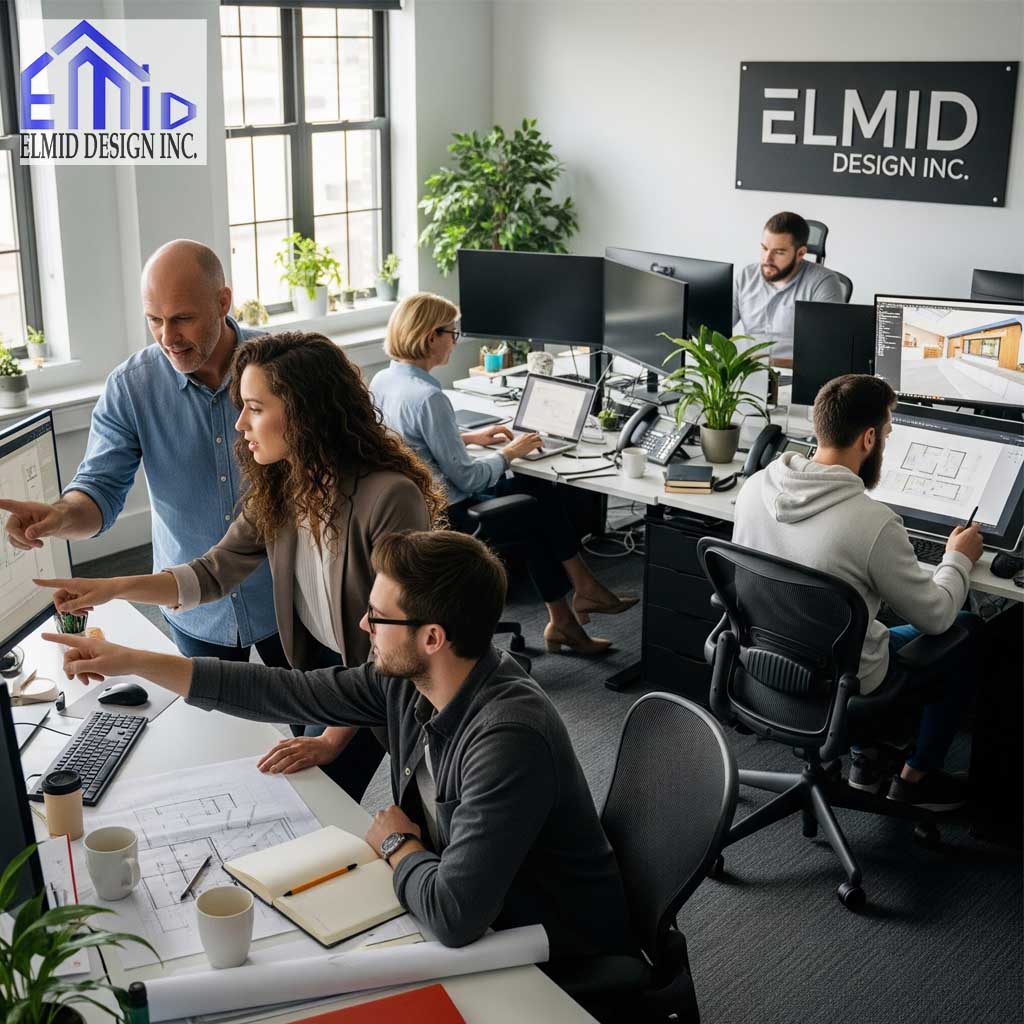
Why Elmid Design Inc Is the Trusted Partner for Permit Drawings Concord
Elmid Design Inc is a licensed engineering firm with a Certificate of Authorization from Professional Engineers Ontario (PEO), offering expert services in structural, architectural, and permit drawings across Concord. Our team ensures every project meets local building codes, zoning bylaws, and design standards. With deep technical knowledge and commitment to accuracy, Elmid Design Inc helps clients navigate the permitting process efficiently and with full compliance. Trusted by homeowners, developers, and contractors alike, we bring experience and precision to every drawing—reinforcing both safety and approval success.
Geographic Locations That We Service:
Our Licensed Professional Engineers specializing in Engineered Site Grading Plans offer the best-engineered site grading plan, lot grading and erosion plan, and drainage plan to obtain site plan approval and building permits in Ontario, including a wide range of municipalities. Each area boasts unique features and requirements, making our tailored approach essential for success.
Toronto and Surrounding Areas
In the vibrant heart of Ontario, we service Toronto (City of Toronto) and surrounding areas. Additionally, we cover Oshawa (City of Oshawa), Pickering (City of Pickering), and Clarington (Municipality of Clarington). Furthermore, our expertise extends to Ajax (Town of Ajax), Whitby (Town of Whitby), Brock (Township of Brock), Scugog (Township of Scugog), and Uxbridge (Township of Uxbridge).
Halton Region
Moving to the Halton Region, our services encompass Burlington (City of Burlington) and Halton Hills (Town of Halton Hills). Also included are Milton (Town of Milton) and Oakville (Town of Oakville).
Peel Region
In the Peel Region, we provide services in Brampton (City of Brampton), Mississauga (City of Mississauga), and Caledon (Town of Caledon).
York Region
Our services in the York Region cover Vaughan (City of Vaughan), Aurora (Town of Aurora), and East Gwillimbury (Town of East Gwillimbury). We also cater to Georgina (Town of Georgina), Markham (City of Markham), Newmarket (Town of Newmarket), Richmond Hill (City of Richmond Hill), Whitchurch-Stouffville (Town of Whitchurch-Stouffville), King (Township of King), and Bradford-West Gwillimbury (Town of Bradford-West Gwillimbury). Each municipality here offers a distinct setting, requiring our specialized approach.
Other Southern Ontario Cities and Towns
We also serve many other cities and towns in Southern Ontario. These include Hamilton (City of Hamilton), St. Catharines (City of St. Catharines), Niagara on the Lake (Town of Niagara on the Lake), Brant (County of Brant), Cambridge (City of Cambridge), Kitchener (City of Kitchener), Waterloo (City of Waterloo), and Woodstock (City of Woodstock). Furthermore, we operate in Guelph (City of Guelph), Centre Wellington (Township of Centre Wellington), Shelburne (Town of Shelburne), Orangeville (Town of Orangeville), New Tecumseth (Town of New Tecumseth), Essa (Town of Essa), Collingwood (Town of Collingwood), Wasaga Beach (Town of Wasaga Beach), Barrie (City of Barrie), Midland (Town of Midland), Orillia (City of Orillia), Ramara (Town of Ramara), Minden Hills (Town of Minden Hills), North Kawartha (Town of North Kawartha), Kawartha Lakes (City of Kawartha Lakes), Peterborough (City of Peterborough), Selwyn (Town of Selwyn), and Brighton (Municipality of Brighton).
